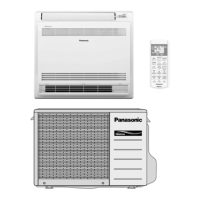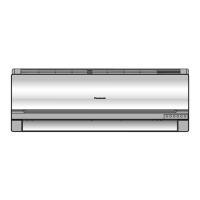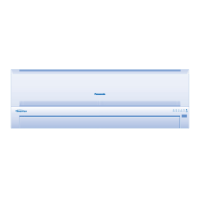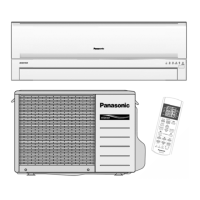39
1
3
4
5
2
0°
145°
Close position
Side view
Figure 2
50°C
30°C
16°C
58°C
37°C
36°C
A
B
D
C
Indoor heat
exchanger temperature
Figure 1
13.2.7 Airflow direction
• There are two types of airflow, vertical airflow (directed by horizontal vane) and horizontal airflow (directed by
vertical vanes).
• Control of airflow direction can be automatic (angles off direction is determined by operation mode, heat
exchanger temperature and intake air temperature) and manual (angles of direction can be adjusted using
remote control).
13.2.7.1 Vertical airflow
Vane Angle (°) Operation
mode
Airflow direction
1 2 3 4 5
CU-E7,9,12,15GK 0 A Upward fix
CU-E18GK 16
CU-E7,9,12,15GK 45 B Downward fix
CU-E18GK 50
CU-E7,9,12,15GK 0 C Upward fix
CU-E18GK 8
CU-E7,9,12,15GK 0
Auto with heat
exchanger
temperature
D Downward fix
CU-E18GK 8
CU-E7,9,12,15GK 12 25 37 49 60
Heating
Manual
CU-E18GK 8 17 33 49 60
CU-E7,9,12,15GK 10 ~ 32 (22 ~ 30) Auto (Anti-Dew Control)
CU-E18GK 8 ~ 38
CU-E7,9,12,15GK 12 (22) 18 25 31 37 (30)
Cooling and
ion
Manual (Anti-Dew Control)
CU-E18GK 8 17 33 49 60
CU-E7,9,12,15GK 10 ~ 32 (22 ~ 30) Auto (Anti-Dew Control)
CU-E18GK 8
CU-E7,9,12,15GK 12 (22) 18 25 31 37 (30)
Soft Dry
Manual (Anti-Dew Control)
CU-E18GK 8 17 25 33 38
• Automatic vertical airflow direction can be set using remote control; the vane swings up and down within the
angles as stated above. For heating mode operation, the angle of the vane depends on the indoor heat
exchanger temperature as figure 1 below. When the air conditioner is stopped using remote control, the vane
will shift to close position.
• Manual vertical airflow direction can be set using remote control; the angles of the vane are as stated above and
the positions of the vane are as figure 2 below. When the air conditioner is stopped using remote control, the
vane will shift to close position.

